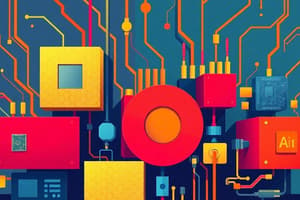Podcast
Questions and Answers
What is the role of hardware in an information system?
What is the role of hardware in an information system?
Hardware provides the physical devices necessary for software applications to run.
Define software in the context of information systems.
Define software in the context of information systems.
Software consists of instructions that govern computational processes in a computer system.
Why is data considered the lifeblood of information systems?
Why is data considered the lifeblood of information systems?
Data is the information collected and stored about entities like customers, products, and transactions.
Explain the importance of the network in an information system.
Explain the importance of the network in an information system.
How do hardware and software components work together in an information system?
How do hardware and software components work together in an information system?
What are the challenges organizations face concerning data in modern information systems?
What are the challenges organizations face concerning data in modern information systems?
What are the core components of network architecture?
What are the core components of network architecture?
How do people contribute to the success of an information system?
How do people contribute to the success of an information system?
What do information processes involve?
What do information processes involve?
Why is security essential in an organization?
Why is security essential in an organization?
How do the core elements of information systems interact with each other?
How do the core elements of information systems interact with each other?
What are the potential consequences of not securing an organization's digital assets?
What are the potential consequences of not securing an organization's digital assets?
Flashcards are hidden until you start studying
Study Notes
Information Systems Components
Information systems (IS) play a vital role in shaping modern businesses by collecting, storing, processing, and disseminating data efficiently. To understand information systems better, it's essential to explore their fundamental composition, which can be broken down into various interconnected parts that work together seamlessly. Here, we delve deeper into these critical pieces of an information system.
-
Hardware: This refers to the physical devices used within an IS environment, including computers, servers, storage equipment, printers, and network infrastructure like routers and switches. These hardware resources provide the foundation upon which software applications run.
-
Software: Software is the set of instructions instructing how computational processes take place in a computer system. It encompasses operating systems, databases, application programs, programming languages, and middleware necessary for communication between different platforms.
-
Data: Data forms the lifeblood of information systems; it is information collected from and stored about entities such as customers, products, employees, or transactions. As the volume of available data continues to grow exponentially, managing this resource effectively has become one of the central challenges facing organizations today.
-
Network: A well-designed network ensures smooth and timely exchange of data among all components of an information system. Network architecture includes local area networks (LAN), wide area networks (WAN), and other technologies facilitating communication across geographical boundaries.
-
People: People remain integral to the success of any information system, whether they're involved in designing, implementing, using, maintaining, or securing it. Skills like creativity, problem-solving abilities, teamwork, and leadership contribute significantly to effective implementation and usage of technology.
-
Processes: Information processes refer to standardized procedures involving the collection, analysis, interpretation, sharing, decision making, and retention of data leading to business value creation. Efficient and streamlined information processes enable organizations to achieve critical operational objectives more quickly and cost-effectively.
-
Security: Security is essential to protect sensitive data against unauthorized access, manipulation, disclosure, destruction, or denial of service. An appropriate security framework must address confidentiality, integrity, availability, accountability, authenticity, and non-repudiation. Failure to secure an organization's digital assets adequately could lead to devastating consequences such as financial losses, loss of reputation, and breaches of legal obligations.
These core elements interact with each other to form robust and efficient information systems tailored to meet specific organizational needs and goals. By understanding these components deeply and keeping them optimally integrated, enterprises have an opportunity to enhance performance, foster innovation, improve customer experiences, and maintain competitive advantage in dynamic marketplaces.
Studying That Suits You
Use AI to generate personalized quizzes and flashcards to suit your learning preferences.




